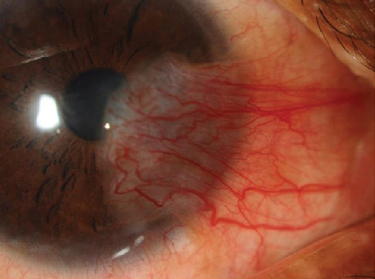 |
| Patients treated for primary pterygium who received mitomycin C were less inclined to experience regrowth in this study. Photo: Amy Humphreys. Click image to enlarge. |
Usually benign but unsightly, pterygium of the ocular surface generally respond well to surgical excision—initially. Recurrence is fairly high, it turns out, according to a new study. Researchers aiming to evaluate risk factors found that the preoperative length of corneal involvement and number of previous pterygium surgeries were significantly correlated with recurrence.
A total of 119 eyes of patients with recurrent pterygium who underwent surgery with a follow-up period of greater than 12 months were analyzed. The clinical characteristics of pterygium were classified according to the length of corneal involvement and Tan grade.
Recurrence was observed in 15 patients (12.6%); 12 of them experiencing it within 12 months. Eyes with recurrence had a significantly greater length of corneal involvement and number of previous surgery. Recurrence was significantly associated with the length of corneal involvement and the number of previous surgeries, but not with sex, age or use of mitomycin C. This medication was used in younger patients and in thicker vascularized pterygium, which may have reduced the recurrence rate, the researchers noted.
“Notably, although the number of patients with binocular diplopia decreased after surgery, it was present in seven of 119 eyes postoperatively in this study, which was comparable to that in previous studies” (0% in 17 eyes and nine of 111 eyes), the authors explained in their paper for the Cornea journal. “Postoperative diplopia is rare, but an important complication that affects binocular function, and preoperative assessment of eye movement is clinically relevant in treating recurrent pterygium.”
The surgical technique did not affect the recurrence rate, and preoperative patient conditions were associated with recurrence. “Among these factors, the length of preoperative corneal involvement and number of previous pterygium surgeries were found to significantly correlate with postoperative recurrence,” the authors explained. “The growth or angiogenesis of pterygium may reflect its proliferative activity, which is associated with recurrence.”
A previous study reported that in primary pterygium, preoperative lesion length, width and area were significantly correlated with recurrence in the univariate analysis, but only vascularity was significantly correlated in the multivariate analysis.
The authors noted that the Tan grade is clinically useful for primary pterygium, but it is difficult to determine the grade of recurrent pterygium because episcleral vessels were not visible in most of the 32 eyes in that study—a possible reason why the Tan grade was not a significant factor for recurrence.
Kusano Y, Den S, Yamaguchi T, et al. Risk factors for recurrence in the treatment of recurrent pterygium. Cornea. September 30, 2023. [Epub ahead of print.] |

